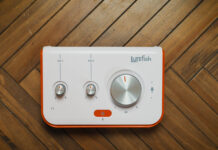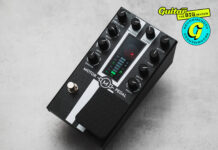
Maker’s Marks: Who really invented the humbucker?
Who invented the humbucker? That’s easy. It was Seth Lover, right? Except Ray Butts got his Filter’Tron patent first, right? Or perhaps they arrived at the idea at the same time? Whichever variation on this answer you go by, the canonical version of events (usually) goes as follows:
READ MORE: Maker’s Marks: How a mysterious phone call led to the discovery of Ray Butts’ pickup-tester guitar
At 1957’s NAMM Show, both Gibson and Ray Butts – with Gretsch – showed up with a humbucking guitar pickup. Gibson’s unit came to be known as the PAF (Patent Applied For) pickup, and was created by the company’s electronics expert Seth Lover. Butts’ pickup was the Filter’Tron, which was used in Gretsch guitars from the late 1950s onwards. There was some fallout after the show but Gibson and Gretsch eventually reached an agreement. Butts and Lover invented their pickups independently of one another, and just happened to do so at the same time – and it’s often assumed that neither party had prior knowledge of what the other was working on.
Only that isn’t true.
Ray Butts revolutionised the guitar world but rarely gets the credit he deservesAs we revealed in issue 381, pickup manufacturer Thomas Vincent ‘TV’ Jones has been granted access to a wealth of Ray Butts’ original schematics, business documents and personal correspondences that has been largely unpublished or unexplored up to this point. Searching through these papers has revealed letters sent to Ray by the then-president of Gibson Ted McCarty, dated 12 October and 21 November 1956. The contents are illuminating to say the least.
The correspondences demonstrate that Gibson did know about the Filter’Tron prior to 1957, that Ray knew about their humbucker, and that both were concerned about a conflict between them.
Ray had found out about Lover’s pickup through its announcement in the October issue of the Gibson Gazette in 1956. He wrote to Gibson immediately and raised the issue, informing them of his own invention. In his first response, McCarty is relatively reserved. “Without knowing the principle of your pickup,” he says, “it is not possible to make a statement regarding the compatibility of the two units.” Ted goes on to write that Gibson had been researching the concept for “quite a few years”, and mentions the company’s patent application for the design, which was dated 22 June 1955.
“The pickup I have is of my own invention. I would like to make it clear that the first model that I made worked successfully, and clearly demonstrated the basic ideas of the invention”
In his second letter, though striking a conciliatory tone, McCarty asserts his belief that Gibson is the originator of the humbucker, and that Ray could be infringing upon its patent by continuing his work on the Filter’Tron. He points out that the patent request for Lover’s design had been made about 18 months previously, and that unless Ray could “prove a prior right”, he should either “cease and desist manufacture or obtain a licence” from Gibson to produce humbucking pickups.
Why the change of approach from McCarty? The opening paragraph of this second letter likely explains it. “It is my understanding that Chet Atkins is playing a new Gretsch instrument which is equipped with two humbucking pickups, which we believe are an infringement of our humbucking design,” he says. When he wrote his first response in October, it seems McCarty was unaware that one of the biggest guitarists in the US was already playing to audiences with Butts’ humbuckers – and the Gibson humbucker wouldn’t even be available until the following year. It’s possible that, upon realising this, Ted took a tougher stance.
This a fascinating letter from one of the key movers and shakers of the early days of the electric guitar, and it reveals something all but unknown about the origins of the humbucker. What’s even juicier than Ted’s defensive manoeuvre, however, is Ray’s response.
Guitarcheologist Thomas Vincent ‘TV’ Jones excavating details from the Butts archiveAcross three hand-written pages, Ray not only sheds more light on this particular portion of guitar history but also provides a solid sense of his character. This was a man unwilling to be cowed by a large company such as Gibson. He agrees that, without comparing the two pickup designs, it’s difficult to draw conclusions on their similarities. But he then matches McCarty’s assertiveness. “The pickup which I have is of my own invention,” says Ray, “and I have good reason to believe that I can prove that my invention was made substantially prior to the one which you have.”
Ray digs in on the patents too. “It is the advice of my attorneys, who have full knowledge of the circumstances as they thus far exist, that my position is a reasonably secure one and that it is very likely that you may find yourself in the position of being an infringer.”
He goes on to add that McCarty’s mention of ceasing work on the Filter’Tron or getting a licence is “presumptuous” but that he would be happy to look at copies of the relevant patents to see if there is indeed an infringement on his part.
It’s likely that Ray then typed up this letter before sending it. But neither the typed version nor any response from Gibson has ever been found. Nevertheless, it’s all too tempting to imagine the Gibson president’s reaction.
Both Butts and McCarty note that development of their respective humbuckers began years before this point and, on the face of it, this only adds to the uncertainties of the timeline. But it’s important to consider everything Ray says in his letter, especially on the second page.
1 of 2
Tom’s dive into the archives has revealed many previously unseen correspondences, including this letter from Gretsch to Ray regarding the pickups he’d made for Chet Atkins, and tense exchanges between Ray and Gibson’s then-president Ted McCarty
“In your letters you seem to be under the impression that the pickup which I have is something which I am working on and do not have perfected,” he says. “I would like to make it clear that for the purposes of the invention the first model that I made worked successfully and clearly demonstrated the basic ideas of the invention.”
Ray goes on to state that all work in the years since has been simply refining and modifying small details. He’s suggesting here that what’s important is not when someone started conceptualising or researching the idea but the point at which they had a functional and fully realised invention. By stating that he began his work years prior, and that his very first humbucking pickup build was successful, Ray is asserting that he got there before Gibson did, who were likely at such a stage in early/mid-1955, before the company’s patent application.
For TV Jones, the confidence of Ray’s response and his intimation of proof to back up his claims is a revelation in itself. “This is so important,” says Jones. “People need to see this.”
The letters inspired Jones to dive into the rest of Butts’ documents with even greater fervour, in case there’s proof that Ray’s invention did indeed arrive before Lover’s. “If there’s evidence here that Ray was already making the Filter’Tron in early ’55 or in ’54, that’s huge,” he says.
However, with many of the artefacts and paperwork not clearly dated, finding such evidence isn’t easy. A document from Ray’s attorneys provides part of the timeline for the development of the Filter’Tron. The itemised bill lists three different matters handled for Ray between 16 July 1954 and 30 November 1956. The services appear to be listed chronologically, and the first of these regards a patent application for a reverb apparatus that Ray invented. Other documents show his work on this apparatus took place in early 1954.
“In many ways, it doesn’t matter who was first. What’s so intriguing is that two brilliant electric guitar pioneers individually devised unique inventions to improve the tone and possibilities of the instrument”
The next matter concerns “services re your new low-hum-level pickup”. This suggests that Ray had asked his attorneys to perform services regarding his humbucking pickup design between early 1954 and November 1956. Ray’s letters to McCarty imply that he only found out about the Gibson pickup in October, and he tells McCarty that he has already spoken with his attorneys. The bill here also states that his lawyers looked into “possible interference with the Gilson co”, presumably meaning Gibson. At least some of this work, then, was carried out in October-November ’56.
But most likely not all of it. With the bill dated 30 November 1956 and with two succeeding items, it’s possible that Ray had first contacted his lawyers regarding the new invention much earlier. The “loud speaker construction” listed after the pickups is shown in other documents to have occupied Ray in early/mid-1956, which suggests that Ray was in contact with his lawyers regarding the pickup a while before his exchange with McCarty.
Another possible hint comes from correspondence between Ray and Chet Atkins. Ray developed his new pickup because Chet was frustrated with the hum from his DeArmonds. Impressed by Ray’s EchoSonic amplifier and other works, Atkins decided that Butts was the only one who could get the pickup right. The two were already exchanging letters in early 1954, at which point Atkins was certain he would use the EchoSonic on his next record. Again, this makes it possible that Ray was tackling the pickup issues for Atkins as early as 1954 and, if his claim that he got the humbucker to work on his first attempt is accurate, this would date the invention to that year. But of course, it’s not quite that easy.
Tom examining the Filter’Tron patent awarded to Ray on 30 June 1959Definitive proof remains elusive. The timelines are full of overlaps, coincidences and simultaneity – even down to the patent applications for Butts’ and Lover’s new pickup designs. Lover applied first and Butts second, and Ray received his first on 30 June 1959, with Lover’s arriving on 28 July.
From these relatively humble beginnings, these remarkable inventions went on to become beloved innovations that changed the world of the electric guitar and popular music. PAFs started appearing in many Gibson models – including the Les Paul Goldtop and Custom – in early 1957. Chet Atkins had told his friends at Gretsch about his new wonder-pickups and insisted on having them in his guitars from that point on. Gretsch contacted Ray in December 1955 asking for more information and stating the company’s interest in his work. Filter’Tron pickups began appearing in Gretsch models in 1957, and replaced almost all other pickups in their line-up over the following years.
The importance of these documents and the stories they’re wrapped up in go beyond the simple matter of who came first. It’s about shedding new light on a principal period of our instrument’s history. Two ingenious inventors, working at roughly the same time, arrived at the same basic solution: an additional coil that could eliminate the hum of guitar pickups. They had similar inspiration (Lover’s came from the use of coils in Gibson amps, Butts’ from Ampex tape heads), they both worked completely independently of one another, and they both deserve equal praise and acknowledgement.
While they both set out to fix the same issue, Butts and Lover created two different schools of pickup-making. The Filter’Tron inhabits a space apart from the PAF and more ‘standard’ humbuckers, both tonally and visually. This is why it’s travelled its own path over the years, and that’s why, when players discover that they like it, they tend to stick with it. Filter’Trons have a sound of their own, with a delicious blend of warmth and clarity. Meanwhile, PAF replication has become an industry in itself, with many blues and rock players regarding Lover’s design as the Holy Grail of guitar tone.
It’s well documented that Lover had a hard time when he applied for his patent, and Ray’s papers reveal that he came up against precisely the same difficulties. The lawyers assisting both were troubled by three pre-existing patents under the names Knoblaugh (1935), Russel (1939) and Keller (1952). These all related to a double-coil design for use with stringed instruments, making the debate about who came first all the trickier. However, the inventions of Seth Lover and Ray Butts were rightly deemed original in their designs and in their specific applications to the electric guitar.
In many ways, it doesn’t matter who was first. What’s so intriguing is that two brilliant electric guitar pioneers individually devised unique inventions to improve the tone and possibilities of the instrument, and their innovations continue to impact and inspire musicians to this day. Popular music wouldn’t sound the same without them.
For more features, click here.
The post Maker’s Marks: Who really invented the humbucker? appeared first on Guitar.com | All Things Guitar.
Source: www.guitar-bass.net













